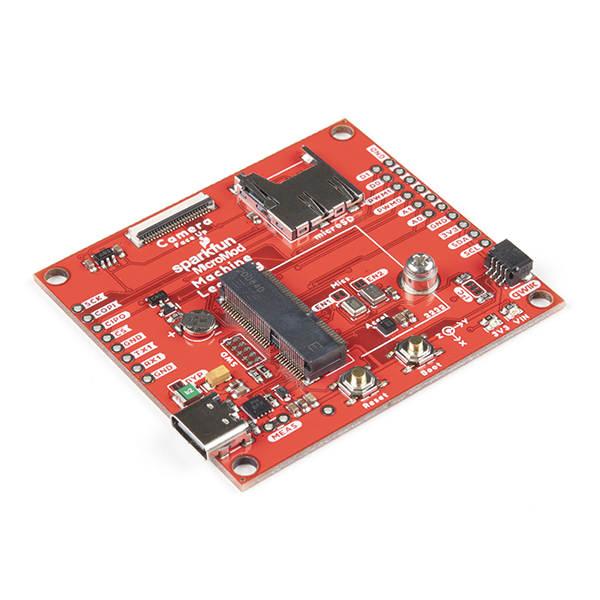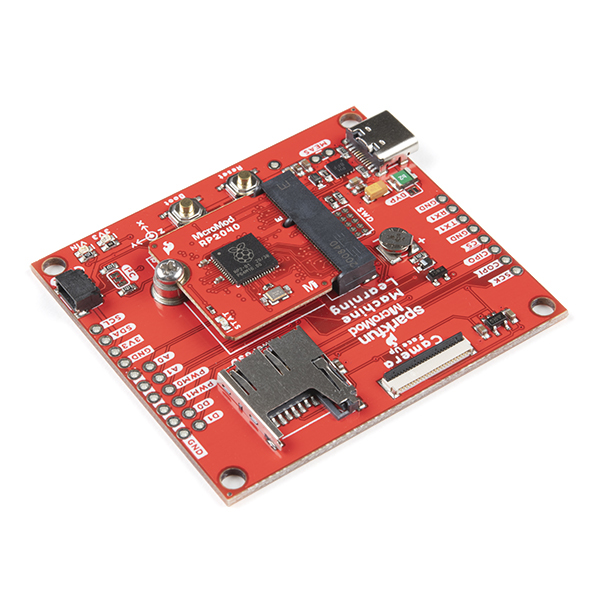×
SparkFun will be closed on Tuesday, December 24th, and Wednesday, December 25th, in observance of the Christmas holiday. Any orders qualifying for same day shipping placed after 2:00 p.m. (MST) on Monday, December 23rd, will be processed on Thursday, December 26th, when we return to regular business hours. Wishing you a safe and happy holiday from all of us at SparkFun!
Please note - we will not be available for Local Pick up orders from December 24th-December 27th. If you place an order for Local Pick-Up we will have those ready on Monday, December 30th.
SparkFun MicroMod Machine Learning Carrier Board
The MicroMod Machine Learning Carrier Board combines some of the features of our SparkFun Edge Board and SparkFun Artemis boards, but allows you the freedom to explore with any processor in the MicroMod lineup without the need for a central computer or web connection. Voice recognition, always-on voice commands, gesture, or image recognition are possible with TensorFlow applications. The cloud is impressively powerful but all-the-time connection requires power and connectivity that may not be available. Edge computing handles discrete tasks such as determining if someone said "yes" and responds accordingly. The audio analysis is done on the MicroMod combination rather than on the web. This dramatically reduces costs and complexity while limiting potential data privacy leaks.
This board features two MEMS microphones (one with a PDM interface, one with an I2S interface), an ST LIS2DH12 3-axis accelerometer, a connector to interface to a camera (sold separately), and a Qwiic connector. A modern USB-C connector makes programming easy and we've exposed the JTAG connector for more advanced users who prefer to use the power and speed of professional tools. We've even added a convenient jumper to measure current consumption for low power testing.
MicroMod is a modular interface ecosystem that connects a microcontroller “processor board” to various “carrier board” peripherals. Utilizing the M.2 standard, the MicroMod standard is designed to easily swap out processors on the fly. Pair a specialized carrier board for the project you need with your choice of compatible processor!
- M.2 MicroMod Keyed-E H4.2mm 65 pin SMD Connector 0.5mm
- Digital I2C MEMS Microphone PDM Invensense ICS-43434 (COMP)
- Digital PDM MEMS Microphone PDM Knowles SPH0641LM4H-1 (IC)
- ML414H-IV01E Lithium Battery for RTC
- ST LIS2DH12TR Accelerometer (3-axis, ultra-low-power)
- 24 Pin 0.5mm FPC Connector (Himax camera connector)
- USB - C
- Qwiic connector
- MicroSD socket
- Phillips #0 M2.5x3mm screw included
MicroMod Machine Learning Carrier Documentation:
MicroMod Documentation:
SparkFun MicroMod Machine Learning Carrier Board Product Help and Resources
Getting Started with MicroMod
October 21, 2020
Dive into the world of MicroMod - a compact interface to connect a microcontroller to various peripherals via the M.2 Connector!
MicroMod Artemis Processor Board Hookup Guide
October 21, 2020
Get started with the Artemis MicroMod Processor Board in this tutorial!
Designing with MicroMod
October 21, 2020
This tutorial will walk you through the specs of the MicroMod processor and carrier board as well as the basics of incorporating the MicroMod form factor into your own PCB designs!
MicroMod Machine Learning Carrier Board Hookup Guide
October 21, 2020
Get hacking with this tutorial on our Machine Learning Carrier Board!
Core Skill: DIY
Whether it's for assembling a kit, hacking an enclosure, or creating your own parts; the DIY skill is all about knowing how to use tools and the techniques associated with them.
Skill Level: Noob - Basic assembly is required. You may need to provide your own basic tools like a screwdriver, hammer or scissors. Power tools or custom parts are not required. Instructions will be included and easy to follow. Sewing may be required, but only with included patterns.
See all skill levels
Core Skill: Programming
If a board needs code or communicates somehow, you're going to need to know how to program or interface with it. The programming skill is all about communication and code.
Skill Level: Competent - The toolchain for programming is a bit more complex and will examples may not be explicitly provided for you. You will be required to have a fundamental knowledge of programming and be required to provide your own code. You may need to modify existing libraries or code to work with your specific hardware. Sensor and hardware interfaces will be SPI or I2C.
See all skill levels
Core Skill: Electrical Prototyping
If it requires power, you need to know how much, what all the pins do, and how to hook it up. You may need to reference datasheets, schematics, and know the ins and outs of electronics.
Skill Level: Rookie - You may be required to know a bit more about the component, such as orientation, or how to hook it up, in addition to power requirements. You will need to understand polarized components.
See all skill levels
Comments
Looking for answers to technical questions?
We welcome your comments and suggestions below. However, if you are looking for solutions to technical questions please see our Technical Assistance page.
Customer Reviews
No reviews yet.






Is A0 connected to GND?
What cameras can be used with this? I see the Himax CMOS Imaging Camera - HM01B0 listed as an accessory. Does that work? Is it the only option?
What processors can talk to the camera? I didn't see any that listed camera support, but I'm pretty sure that at least the ESP32 should be capable (if the required pins are brought out).
How to interface camera with nrf52840 MicroMod, Are there any sample code provided?
Why the microphones are underneath the processor? Will it work well in spite of that?
The sound port of the microphones is on the bottom of the package (see the two holes in the bottom of the PCB). You could think of the holes on the bottom as the microphone sound input, so the board 'listens' to acoustic inputs coming from the bottom - the opposite side of the board from the processor.